2: The Future of VR in Classrooms: A Brave New Virtual World of Learning?
You might wonder what the future of classroom VR looks like, then. For example, VR works best with subjects and curricular content that’s visual and tactile instead of abstract and conceptual. Philosophy and grammar are not as well suited for VR—but history? Take me on Paul Revere's ride and let me hear and see President Lincoln’s Gettysburg Address as if I were there!
Are your students going to become couch potatoes at home with their headsets on while you have no control over how they interact with you and their classmates? You may also be concerned about how students will develop social skills in a virtual environment.
Some elementary school teachers, college professors and administrators remain unconvinced that trying out VR in the classroom is a worthwhile investment of precious resources.
Reservations about the technology include:
- Perceptions of high costs
- The bulkiness of some VR headset units
- Uncertainty over the availability and effectiveness of VR lesson content
- Concerns over potential pushback from parents about VR content they may object to
Another common negative perception is that VR is only for entertainment, like video games. The truth is that breakthroughs in entertainment hardware and software are helping fuel progress in developing VR as a powerful learning tool. Despite the perception challenges, industry analysts project that demand for VR in education will show real growth in the coming years.
3: The Best of Both Worlds (Real and Virtual)
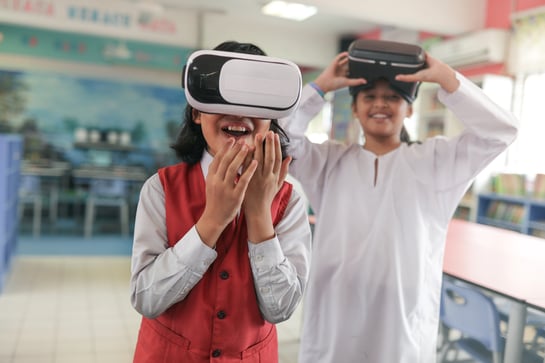
Innovative educators are ready to blaze a trail for others to follow. With adequate training and a proper balance of technology access, educators can combine old and new pedagogical methods for better learning outcomes.
Anyone who has tried the latest VR tools designed for the classroom will tell you that VR can bring academic studies to life in three enveloping dimensions. Immersive VR lessons feature vibrant colors and stunning detail, free from the restraints of classrooms with four walls, immersing students in new sights and sounds and empowering them to see the world from a variety of perspectives, old and new.
Like any classroom teaching tool, VR is no substitute for in-person student-teacher interactions. Teaching and learning is a social activity, so naturally, VR delivers the most long-term value when used as intended, as a powerful but supplemental tool in an educator’s kit.
According to Bluum’s CEO, Erez Pikar, "We have reached the point where technology with immense educational applications like VR has made this quantum leap from something that storytellers once dreamed of to now becoming a hardware and software tool that educators can really use. Teachers can harness the power of VR to craft a narrative-driven learning experience or create a learning environment that makes it easier to teach highly complex material. And they can take advantage of a large and growing selection of compelling VR lessons that are dynamic, fun and emotionally engaging,” said Pikar.
4: More Than Just Another Way to Play Games or Watch Movies
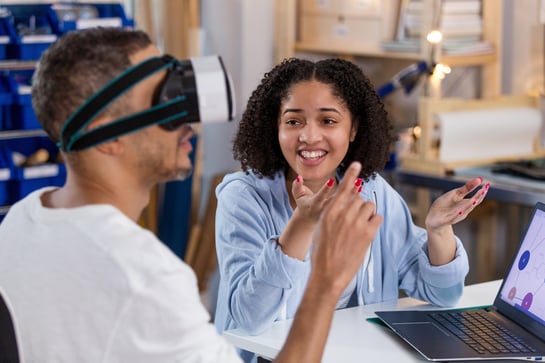 While some VR games are amazingly entertaining and jaw-droppingly immersive, VR is not just another gaming platform. Nor will it bring about any Hollywood sci-fi scenarios like “The Lawnmower Man” or “The Matrix” anytime soon.
While some VR games are amazingly entertaining and jaw-droppingly immersive, VR is not just another gaming platform. Nor will it bring about any Hollywood sci-fi scenarios like “The Lawnmower Man” or “The Matrix” anytime soon.
Remember when Keanu Reeves’ character, Neo, first learned Kung Fu via download and VR training? “Whoa!” That’s not happening in “real reality” this decade, although you may be able to choose VR instead of IMAX as a movie viewing format.
Outside of lucrative fantasy lands and big-budget fiction, VR has many real-world applications, as demonstrated by professionals using it now for things like simulations and practice exercises. Entertainment is just one of the industries that will see transformation driven by VR. Education is another.
With access to a VR headset, you can take your students on trips that would otherwise be impossible or impractical. For example, specific scientific programs allow you to take a tour of the body as a single molecule, traveling through the bloodstream to bring a deeper understanding of human anatomy. In VR, students can zoom in to study the nucleus of an atom, then zoom out to observe the structure of a spiral galaxy.
Additionally, VR can make it difficult to grasp subject matter easier to understand. For example, seeing quantities, ratios, fractions and percentages visualized can help young students develop a deeper understanding of key mathematical concepts.
Visualizations are particularly helpful for students who struggle with the subject. For instance, by visualizing algebraic equations involving speed and distance, students can now see real-world applications right in front of their eyes. Rather than having the Doppler effect explained to them in words, they can see it and hear it in a visualization of a train or ambulance passing by.
The teaching and learning possibilities are nearly limitless with VR, and we have only scratched the surface of this immersive technology’s potential for education.
5: Classroom VR – Pros and Cons
As with any new technology, VR has some drawbacks in classrooms. However, the benefits greatly outweigh the negatives.
VR Pros
Many experts say VR allows for more focus, especially in short periods of intense concentration, leaving memorable impressions and instilling experiential knowledge. The in-depth immersion of VR can block out distractions, such as fellow students, boredom, or that birdie outside the window, which can be much more interesting than whatever the teacher has to say—we all remember those days.
VR also doesn't feel like learning. Remember when your primary school teacher rolled the old TV cart into the classroom, and the entire class breathed a sigh of relief at getting a break from “chalk and talk” teaching? The same can be said about VR, especially when students learn in collaborative virtual spaces together. For example, a VR field trip to the Precambrian or Jurassic eras before humans walked planet Earth, or a quick visit to our prehistoric past when early humans invented tools that would lead to VR time travel.
Students can improve their writing and storytelling by describing their VR experiences in words, maybe even words written on paper, a most ancient education technology. While students retain crucial information, they are also more engaged in the VR lesson, having more fun, making memories and absorbing knowledge without even trying.
VR Cons
Some teachers have concerns about human connection. Will students cut themselves off if they use VR too much? It’s an understandable concern, but largely unwarranted. Educators and product manufacturers recommend tight limits on VR lesson time, addressing this potential issue.
It’s extremely unlikely that any schools in our time will transition to VR learning full-time. Student interaction and social skills are essential to every child’s wellbeing and development, especially in the post-pandemic era in which educators and parents are paying greater attention to the mental health of students.
Another drawback of VR is that new technology can be expensive. The latest smartphones show that. However, the prices of VR headsets are decreasing quickly, and more affordable options are hitting the EdTech market every month.
While funding headsets for each student may be demanding for many schools, the same was once true for computing devices, and now many K-12 school districts can equip all their students with laptops or tablets. When more schools adopt VR and document improved student engagement, it is sure to become a commonplace EdTech option in classrooms. Eventually, schools that lack VR will find themselves at a disadvantage as its pedagogical power grows with each new device lifecycle.
Lastly, some educators have expressed a desire for more VR lesson content before taking the plunge. EdTech companies like ClassVR that make these next-generation learning tools are listening and responding with vast new selections of immersive learning experiences tailored to every grade level and comfort level.
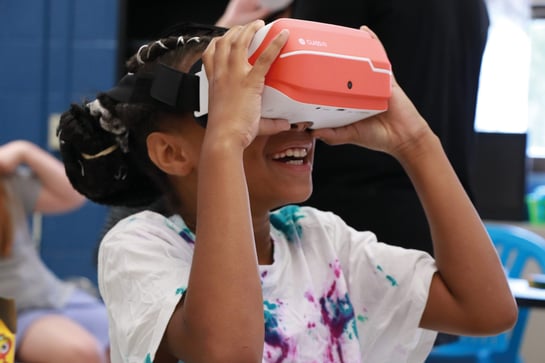
Ready to Enter the Future with VR in Your Classroom?
When it comes to learning, there is hope for a brighter future enhanced by technology such as VR. Classroom VR is paving the way for a new wave of education and with it, better outcomes for students from pre-kindergarten through college and beyond.
Discover more tools for bringing learning to life or reach out to us to find out how we can help you make VR a reality for your school.


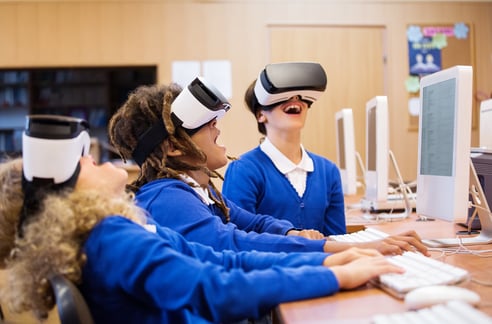
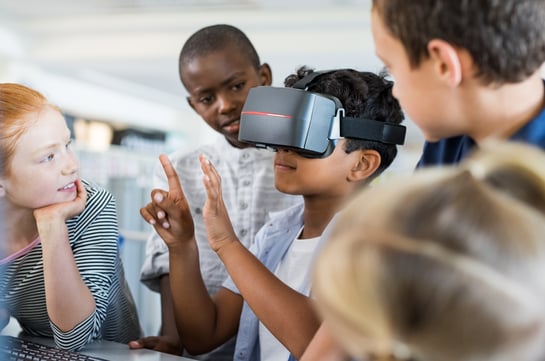 How can VR enhance the learning experience? Think of your early school years. What do you remember impressing you and inspiring you most? Do you remember chalkboards and repeating days' worth of textbook information? Or perhaps an exciting fact or captivating experience from a school field trip stayed in your mind?
How can VR enhance the learning experience? Think of your early school years. What do you remember impressing you and inspiring you most? Do you remember chalkboards and repeating days' worth of textbook information? Or perhaps an exciting fact or captivating experience from a school field trip stayed in your mind?